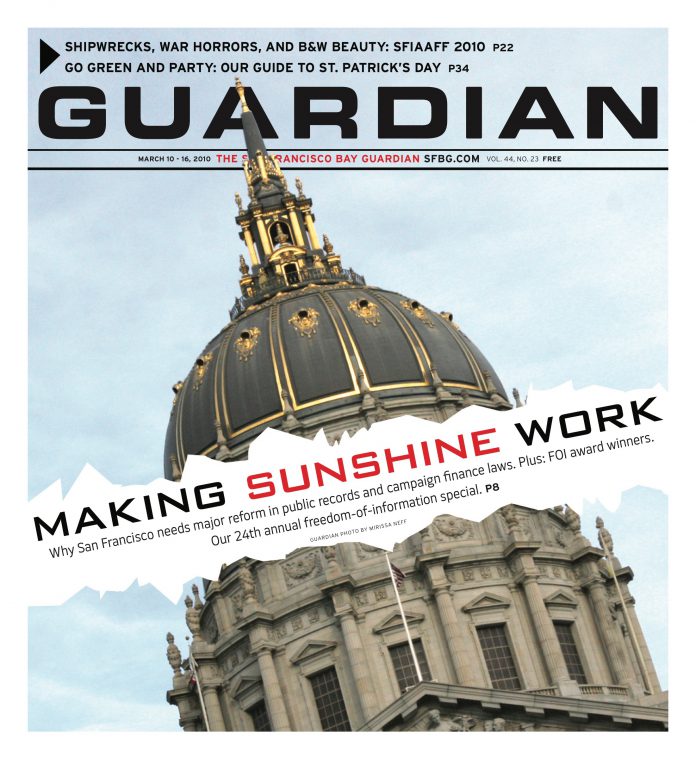arts@sfbg.com
SF INTERNATIONAL ASIAN AMERICAN FILM FESTIVAL All that is solid melts not into air, but is milled into rebar in Jason Byrne’s mesmerizing, nearly hour-long short film, Scrap Vessel. The centerpiece of the San Francisco International Asian American Film Festival’s experimental shorts program, “Memory Vessels and Phantom Traces,” Scrap Vessel is Byrne’s documentation of the final voyage of the Hari Funafuti — formerly a Chinese coal freighter called Hupohai that was built in Norway in 1973 to make hauls around northern Europe — as it sails from Singapore to Bangladesh to be gutted and dismantled for scrap.
Byrne, along with fellow cameraman Theron Patterson, explore the soon-to-be-ghost ship from bottom to top. Their 16mm camera frequently transforms the mechanically mundane — pounding pistons, a flickering fluorescent light, the pleasant geometry of the ship’s gigantic, mastaba-like hold covers — into something formally beautiful, thanks in part to a palette of smudged greens, inky blues, and the occasional brilliant flash of chartreuse. However, their investigation is not solely aesthetic.
For, as often happens in suspense and horror films set at sea, the filmmakers, along with the Bangladeshi crew, discover that they are not entirely alone (one current crew member worries that the previous crew might have sabotaged the ship, resenting their vessel’s forced retirement to the ironworks). No such malfeasance manifests itself, but material traces of the ship’s Communist past-life keep surfacing. A bunch of 35mm photos of the captain and his men visiting a Buddhist shrine are discovered in the captain’s quarters, along with a cassette of easy listening tunes sung in Mandarin. The most dramatic find is 15 cases of 16mm Chinese films that were sitting in a still-locked room labeled “Rec/Film.”
Byrne touchingly weaves these remnants into the fabric of his film, showing us a slideshow of the vacation snaps, using the cassette to augment Albert Ortega’s original score of spooky ambient electronica, and suspending his narrative to interject a montage of the leftover mainland films (including scenes from what looks to be a campy, propagandistic romantic drama). It’s not much. But it’s enough of a hook to cause one to feel something close to sadness when the Hari Funafuti finally reaches its terminus and we witness its gradual destruction.
Byrne pans over several docked ships, rusting and already in the process of being dismantled for scrap, that resemble nothing so much as the rotting carcasses of beached whales. Even before the Hari Funafuti has docked, the scent of fresh blood seems to be on the water: pirates make a failed attempt to remove the propeller for its bronze and Bangladeshi naval officers come aboard to remove reusable communication equipment for their own fleet.
It might seem odd to speak of a commercial freighter in such elegiac terms. Better that it be melted down into materials used to build something new, rather than simply be left to rot on the sea floor or in a junkyard somewhere. And yet, if the Hari Funafuti‘s journey from Norse factory to the Yangtze to a rolling mill in Chittagong is, to some degree, the story of the shifting geographic centers (from Europe to China to South Asia) of industrial manufacturing under globalization, is that not all the more reason to attempt to preserve the human elements of that story?
Scrap Vessel answers, however modestly, in the affirmative. Byrne’s film becomes the true scrap vessel of its title, ensuring that the memory of those who have called his subject home at some point over its 32 years will continue on long after any material traces of the vessel have disappeared — even if only within the span of an independently produced, experimental documentary.
“MEMORY VESSELS AND PHANTOM TRACES” SHORTS PROGRAM
Mon/15, 6:45 p.m., Sundance Kabuki
March 17, 4:45 p.m., Viz

